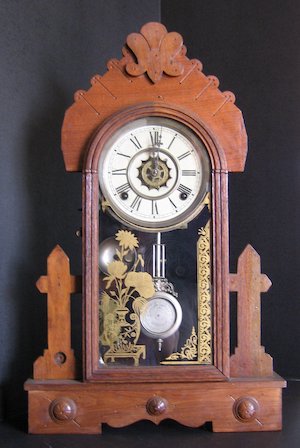
Waterbury mantle clock, c. 1900. Owned by the Mendocino Lumber Company and subsequently owned by the Paoli family. Inscribed “Waterbury Clock Co.; Waterbury, Conn. USA.” Currently on display in the Kelley House Museum. (Gift of Hazel Paoli)
November 3, 1913 – Clocks at the mill were set ahead 20 minutes. This practice was carried out annually during the early days to allow employees a longer period of daylight for their work, since the oil lanterns needed to light the mill in the dark were a constant fire danger.
Life in town revolved around the local mill time. When the mill office clock showed the appointed time, someone in the office went into the plant and pulled the steam whistle.
In “Big River was Dammed,” Francis Jackson described the importance of the whistle. “The mill whistle could be heard for miles around. Clocks were set by it and lives were regulated by it. Old timers said they could hear the first whistle blast in the morning saying, “Get up and get down to the mill!” The second whistle meant it was time to finish breakfast, pick up the lunch pail and make the hurried walk down the hill to the mill. The noon whistle not only signaled that it was time for worker’s lunch break, but meant that it was 12 o’clock, time for lunch recess at school, time to close the bank and other businesses for the noon hour. When the last whistle of the day blew in the evening, housewives began their final preparation for supper. It was a sad day when the mill whistle blew for the last time on November 30th, 1938.”
Mendocino City: A Daily Journal 1852-1938 by W. Francis Jackson – Historical Mendocino news organized by day. Each month includes collections of photos and a detailed map of the town. $18.